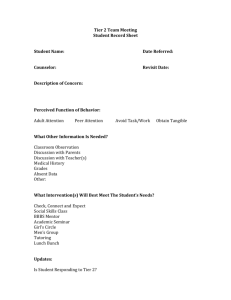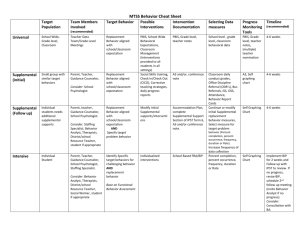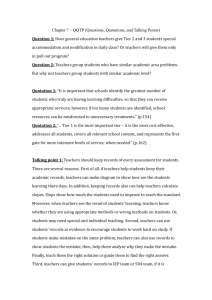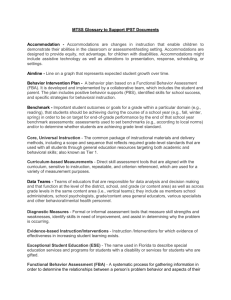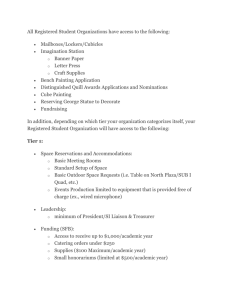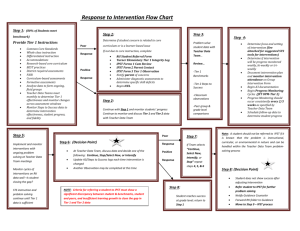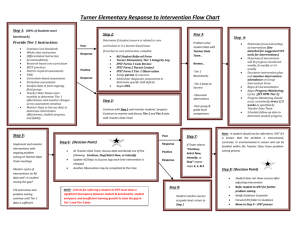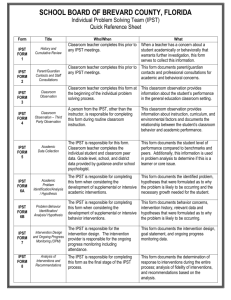Quick Guide to MTSS Process Flow Chart
advertisement
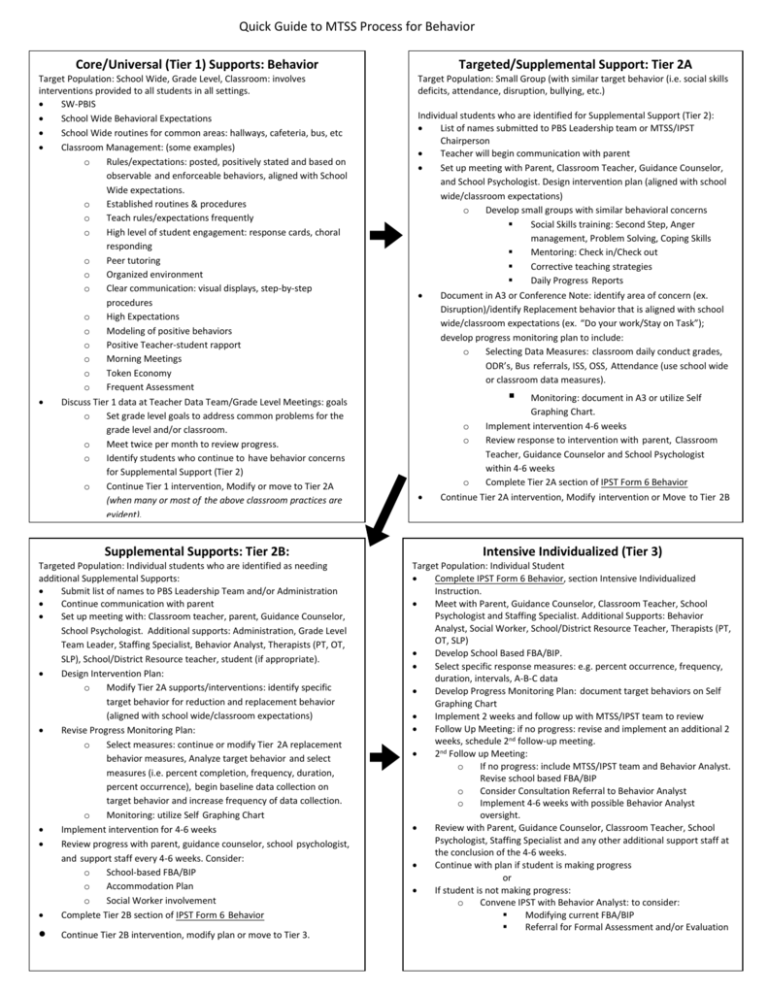
Quick Guide to MTSS Process for Behavior Core/Universal (Tier 1) Supports: Behavior Target Population: School Wide, Grade Level, Classroom: involves interventions provided to all students in all settings. SW-PBIS School Wide Behavioral Expectations School Wide routines for common areas: hallways, cafeteria, bus, etc Classroom Management: (some examples) o Rules/expectations: posted, positively stated and based on observable and enforceable behaviors, aligned with School Wide expectations. o Established routines & procedures o Teach rules/expectations frequently o High level of student engagement: response cards, choral responding o Peer tutoring o Organized environment o Clear communication: visual displays, step-by-step procedures o High Expectations o Modeling of positive behaviors o Positive Teacher-student rapport o Morning Meetings o Token Economy o Frequent Assessment Discuss Tier 1 data at Teacher Data Team/Grade Level Meetings: goals o Set grade level goals to address common problems for the grade level and/or classroom. o Meet twice per month to review progress. o Identify students who continue to have behavior concerns for Supplemental Support (Tier 2) o Continue Tier 1 intervention, Modify or move to Tier 2A (when many or most of the above classroom practices are evident). Supplemental Supports: Tier 2B: Targeted Population: Individual students who are identified as needing additional Supplemental Supports: Submit list of names to PBS Leadership Team and/or Administration Continue communication with parent Set up meeting with: Classroom teacher, parent, Guidance Counselor, School Psychologist. Additional supports: Administration, Grade Level Team Leader, Staffing Specialist, Behavior Analyst, Therapists (PT, OT, SLP), School/District Resource teacher, student (if appropriate). Design Intervention Plan: o Modify Tier 2A supports/interventions: identify specific target behavior for reduction and replacement behavior (aligned with school wide/classroom expectations) Revise Progress Monitoring Plan: o Select measures: continue or modify Tier 2A replacement behavior measures, Analyze target behavior and select measures (i.e. percent completion, frequency, duration, percent occurrence), begin baseline data collection on target behavior and increase frequency of data collection. o Monitoring: utilize Self Graphing Chart Implement intervention for 4-6 weeks Review progress with parent, guidance counselor, school psychologist, and support staff every 4-6 weeks. Consider: o School-based FBA/BIP o Accommodation Plan o Social Worker involvement Complete Tier 2B section of IPST Form 6 Behavior Continue Tier 2B intervention, modify plan or move to Tier 3. Targeted/Supplemental Support: Tier 2A Target Population: Small Group (with similar target behavior (i.e. social skills deficits, attendance, disruption, bullying, etc.) Individual students who are identified for Supplemental Support (Tier 2): List of names submitted to PBS Leadership team or MTSS/IPST Chairperson Teacher will begin communication with parent Set up meeting with Parent, Classroom Teacher, Guidance Counselor, and School Psychologist. Design intervention plan (aligned with school wide/classroom expectations) o Develop small groups with similar behavioral concerns Social Skills training: Second Step, Anger management, Problem Solving, Coping Skills Mentoring: Check in/Check out Corrective teaching strategies Daily Progress Reports Document in A3 or Conference Note: identify area of concern (ex. Disruption)/identify Replacement behavior that is aligned with school wide/classroom expectations (ex. “Do your work/Stay on Task”); develop progress monitoring plan to include: o Selecting Data Measures: classroom daily conduct grades, ODR’s, Bus referrals, ISS, OSS, Attendance (use school wide or classroom data measures). Monitoring: document in A3 or utilize Self Graphing Chart. o Implement intervention 4-6 weeks o Review response to intervention with parent, Classroom Teacher, Guidance Counselor and School Psychologist within 4-6 weeks o Complete Tier 2A section of IPST Form 6 Behavior Continue Tier 2A intervention, Modify intervention or Move to Tier 2B Intensive Individualized (Tier 3) Target Population: Individual Student Complete IPST Form 6 Behavior, section Intensive Individualized Instruction. Meet with Parent, Guidance Counselor, Classroom Teacher, School Psychologist and Staffing Specialist. Additional Supports: Behavior Analyst, Social Worker, School/District Resource Teacher, Therapists (PT, OT, SLP) Develop School Based FBA/BIP. Select specific response measures: e.g. percent occurrence, frequency, duration, intervals, A-B-C data Develop Progress Monitoring Plan: document target behaviors on Self Graphing Chart Implement 2 weeks and follow up with MTSS/IPST team to review Follow Up Meeting: if no progress: revise and implement an additional 2 weeks, schedule 2nd follow-up meeting. 2nd Follow up Meeting: o If no progress: include MTSS/IPST team and Behavior Analyst. Revise school based FBA/BIP o Consider Consultation Referral to Behavior Analyst o Implement 4-6 weeks with possible Behavior Analyst oversight. Review with Parent, Guidance Counselor, Classroom Teacher, School Psychologist, Staffing Specialist and any other additional support staff at the conclusion of the 4-6 weeks. Continue with plan if student is making progress or If student is not making progress: o Convene IPST with Behavior Analyst: to consider: Modifying current FBA/BIP Referral for Formal Assessment and/or Evaluation
